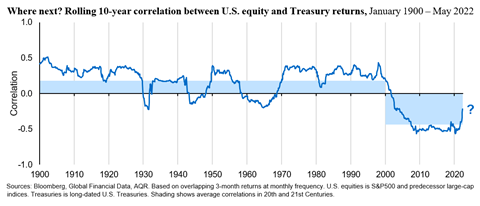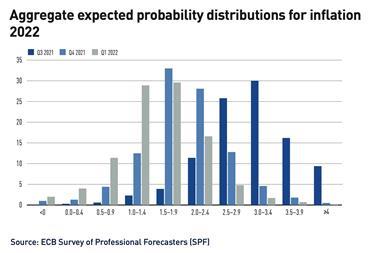This key portfolio parameter may be changing due to challenging market conditions
The relationship between stock and bond returns is a fundamental determinant of risk in many portfolios. For the past two decades the stock/bond correlation (henceforth SBC) has been consistently negative, a boon to many investors who have been able to rely on their bond investments for protection when equities sell off.
But this hasn’t always been the case, and macroeconomic changes – such as higher inflation uncertainty – could lead to a reappearance of the positive SBC of the ’70s, ’80s and ’90s. This would have broad implications for some investors, either increasing portfolio risk or forcing allocation changes likely to reduce expected returns.
For pensions funds, the impact of the SBC is more ambiguous. A negative correlation is not at all helpful if it means assets shrink at the same time that liabilities grow because of falling discount rates. Conversely, a positive correlation is not so bad if it means both sides of the balance sheet move together.
Also, pension funds’ bond holdings may be primarily intended as liability hedges rather than equity risk diversifiers. This means that while some investors may only now be looking beyond bonds for diversification, many pension funds are already familiar with the search for alternative diversifiers (more on this below).

Drivers of the SBC
Equity and bond market returns tend to have opposite exposures to economic growth news, but directionally similar exposures to inflation news. It follows that the SBC is pushed negative when there is more growth news (or uncertainty), and pushed more positive when there is more inflation news (or uncertainty).

The relation between growth and inflation also matters: since equities are driven more by growth and bonds by inflation, the SBC will be pushed more negative when growth and inflation news align (think demand-pull inflation). Supply-driven inflation shocks that also depress growth will tend to push the correlation in a positive direction.
Some commentators have proposed the level of inflation as the key determinant of the SBC (after all, it was positive in the high-inflation ’70s), but “The Stock/Bond Correlation,” a paper recently published on AQR’s website, we and our co-authors use a simple model to illustrate that both theory and an analysis of historical data suggest the amount of inflation uncertainty (relative to growth uncertainty) is the key driver of SBC regimes. Of course, high uncertainty often coincides with a high level of inflation.
We focus on longer-term regimes in our paper, but shorter-term fluctuations in the SBC may have other drivers. A pure monetary policy shock sends both asset returns the same way via the discount rate, but such shocks are hard to disentangle from related growth and inflation news. Flight-to-quality effects can intensify a negative SBC. Finally, any credit risk in bonds will push the SBC upward and can vary over time.
Navigating a changing SBC
If the performance of stock and bond allocations does become more correlated, a ‘third allocation’ – diversifying to both traditional asset classes – may be able to make up the diversification deficit. What investments could fit the bill?
- Illiquid alternatives like private equity and private credit may provide some cushion against short-term volatility due to their lack of mark-to-market pricing, but their diversification potential is limited as they share the same underlying economic exposures as their public market equivalents (we call this ‘slow beta’).
- Commodities have been lowly correlated to both stocks and bonds on average, and have delivered stronger diversification during periods of high inflation uncertainty.
- Dynamic strategies such as long/short equity, alternative risk premia and trend following use financial tools like shorting and leverage to deliver lowly-correlated returns. Trend and macro strategies have tended to thrive on inflation uncertainty, which makes them particularly interesting candidates as diversifiers in positive-SBC scenarios.
Outlook
In mid-2022, inflation uncertainty is undoubtedly higher than it has been for several decades. But long-term expectations remain reasonably well-anchored, and central bank credibility has been (up to now) broadly intact. The SBC has wavered but was mostly negative in H1 2022.

A sustained shift to a positive SBC regime would probably require a rise in longer-term inflation uncertainty, accompanied by further supply-driven inflation shocks and/or monetary policy errors, and this scenario remains a material tail risk for many investors.
Pension funds may rather fear a ‘2008 redux’ recession scenario with falling equity markets and a return to falling bond yields and growing liabilities. Bond allocations are not only liability hedges but also, more broadly, provide asset diversification in this alternative scenario.
This is why we do not advocate aggressive deallocation from bonds, but rather a focus on increasing the size and diversifying power of the alternatives allocation.
In short, diversification could become a scarcer commodity in the 2020s, but it’s out there.
AQR Capital Management is a global investment management firm, which may or may not apply similar investment techniques or methods of analysis as described herein. The views expressed here are those of the authors and not necessarily those of AQR. Diversification does not eliminate the risk of experiencing investment losses. This document is for information purposes and does not constitute an offer or solicitation of an offer, or any advice or recommendation, to purchase any securities or other financial instruments, and may not be construed as such.
















No comments yet